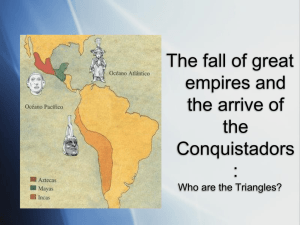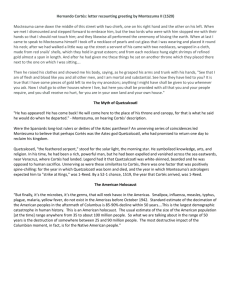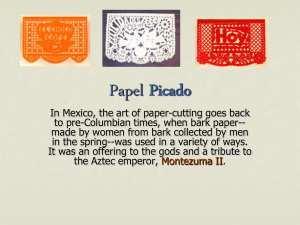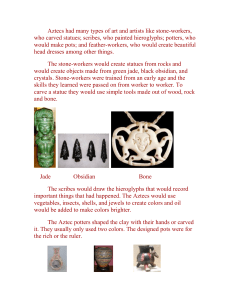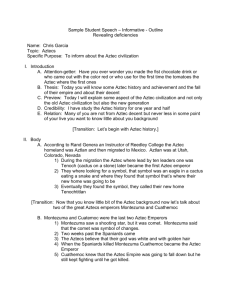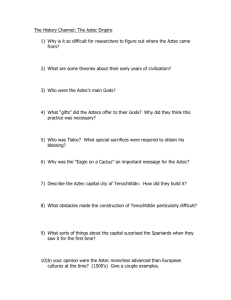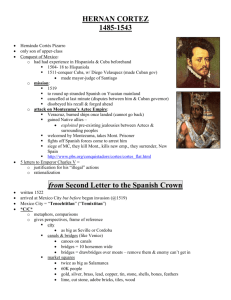2While the Spanish ground the West Indies their
advertisement
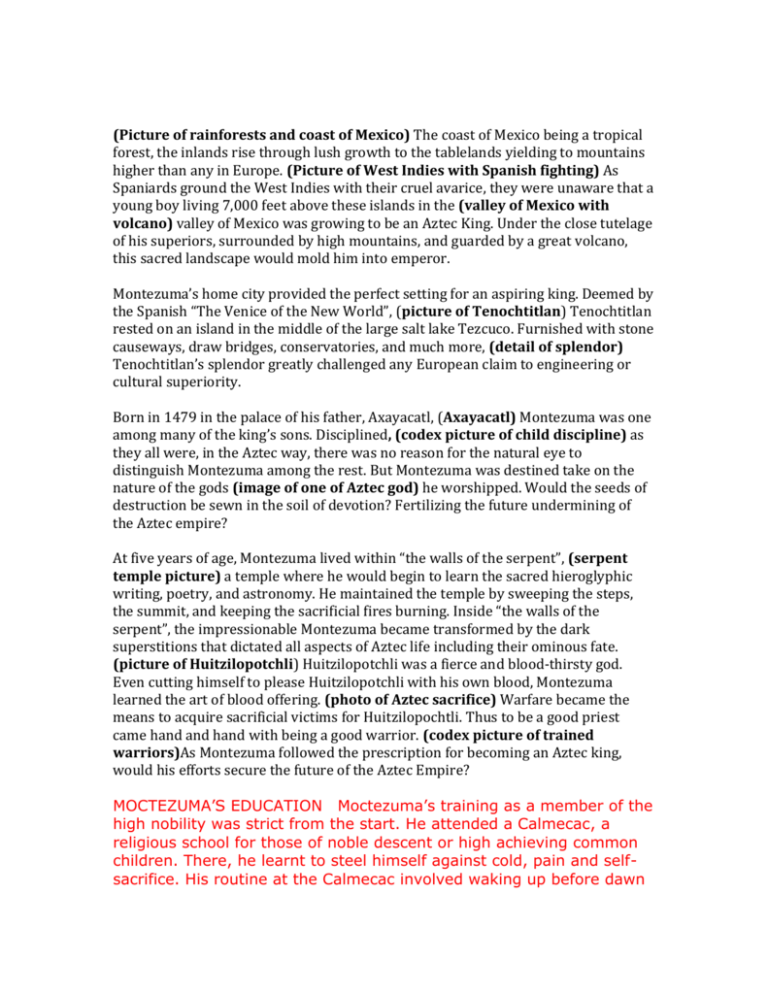
(Picture of rainforests and coast of Mexico) The coast of Mexico being a tropical forest, the inlands rise through lush growth to the tablelands yielding to mountains higher than any in Europe. (Picture of West Indies with Spanish fighting) As Spaniards ground the West Indies with their cruel avarice, they were unaware that a young boy living 7,000 feet above these islands in the (valley of Mexico with volcano) valley of Mexico was growing to be an Aztec King. Under the close tutelage of his superiors, surrounded by high mountains, and guarded by a great volcano, this sacred landscape would mold him into emperor. Montezuma’s home city provided the perfect setting for an aspiring king. Deemed by the Spanish “The Venice of the New World”, (picture of Tenochtitlan) Tenochtitlan rested on an island in the middle of the large salt lake Tezcuco. Furnished with stone causeways, draw bridges, conservatories, and much more, (detail of splendor) Tenochtitlan’s splendor greatly challenged any European claim to engineering or cultural superiority. Born in 1479 in the palace of his father, Axayacatl, (Axayacatl) Montezuma was one among many of the king’s sons. Disciplined, (codex picture of child discipline) as they all were, in the Aztec way, there was no reason for the natural eye to distinguish Montezuma among the rest. But Montezuma was destined take on the nature of the gods (image of one of Aztec god) he worshipped. Would the seeds of destruction be sewn in the soil of devotion? Fertilizing the future undermining of the Aztec empire? At five years of age, Montezuma lived within “the walls of the serpent”, (serpent temple picture) a temple where he would begin to learn the sacred hieroglyphic writing, poetry, and astronomy. He maintained the temple by sweeping the steps, the summit, and keeping the sacrificial fires burning. Inside “the walls of the serpent”, the impressionable Montezuma became transformed by the dark superstitions that dictated all aspects of Aztec life including their ominous fate. (picture of Huitzilopotchli) Huitzilopotchli was a fierce and blood-thirsty god. Even cutting himself to please Huitzilopotchli with his own blood, Montezuma learned the art of blood offering. (photo of Aztec sacrifice) Warfare became the means to acquire sacrificial victims for Huitzilopochtli. Thus to be a good priest came hand and hand with being a good warrior. (codex picture of trained warriors)As Montezuma followed the prescription for becoming an Aztec king, would his efforts secure the future of the Aztec Empire? MOCTEZUMA’S EDUCATION Moctezuma’s training as a member of the high nobility was strict from the start. He attended a Calmecac, a religious school for those of noble descent or high achieving common children. There, he learnt to steel himself against cold, pain and selfsacrifice. His routine at the Calmecac involved waking up before dawn and performing rituals for the gods such as sweeping, bathing in cold water, letting blood from his ears and legs and tending to gods’ shrines. Moctezuma’s intellect and hard work were instrumental in his development as a priest and later on in life he would gain the privilege of performing sacrificial rites. A youth, he would train alongside commoners and learn to become a warrior. As a young noble, he was unaccustomed to receiving special attention. As a young man, Moctezuma won a competition by being the first to climb up a tall pole and grab the effigy of the fire deity, Xiuhtecuhtli, during the harvest festivity of Xócotl Uetzi,”Great Fall of the Xócotl Fruit”. This earned him the honour of becoming one of the four priests that held down a sacrificial victim, live image of Xiuhtecuhtli, whose heart was extracted. The venture up the pole was not only a development for his religious career; Moctezuma showed his skill as an athlete, by reaching the top before any of his competitors, noble or common. Illustration by Miguel Covarrubias of the Xócotl Uetzi pole-climbing competition (Click on image to enlarge) Upon the death of the last ruling uncle in 1502, the nobles went out in search of the destined youth. They found Montezuma humbly sweeping the temple steps in service to his gods. (temple again) Montezuma’s apparent modesty had won their favor and instantly the noble Tezcuce, Nezahualpilli (picture of King Nezahualpilli) made the customary coronation speech. (coronation stone) “ The Mexican Empire is at the height of its power. Rejoice, o happy land that you are destined to have a prince prove to be a father and a brother to his subjects. A king who will not seize the occasion of his exaltation to give himself up to luxury, but rather to attend to all your interests”(coronation stone) His subjects were filled with the hopes of a benevolent leader. (picture of subjects in Tenochtitlan before leader) He began his reign by retiring to the temple to begin a four day fast. His fast broken, he was conducted with rejoicing to the palace for the coronation ceremony. Predictably, Montezuma came forth obsessed with Huitzilopotchli believing that his devotion to this blood-thirsty god would benefit the destiny of his empire. Subsequently, Montezuma set out for war (codex picture of warriors, prisoners of war) with the purpose of acquiring prisoners: sacrificial victims to appease Huitzilopotchli. (picture of Huitzilopotchli) Aztec subjects celebrated Montezuma’s coronation magnificently. They crowned him with the gold and feathered diadem upon his return from war and in anticipated the emperor’s humility and respect. (Montezuma’s crown) These Aztec subjects were sadly deceived in their assessment of Montezuma’s display of humility. Montezuma fervently devoted himself to the gratification of the blood-thirsty god of war, Huitzilopotchli. (codex sacrifice picture) Never before, nor ever since, has a Mexican king lived so opulently and mercilessly. Huitzilopotchli’s thirst for blood incarnated in Montezuma, the recently conquered Aztec subjects of the remote provinces became his feeding grounds. To these inhabitants, Montezuma was a hard and dreaded task-master. Montezuma had tilled the fallow ground of his empire with oppression rather than mercy and would soon suffer the fruit of it. Had Montezuma turned toward his subjects with mercy, the Spanish might have encountered a stronger opposition when attempting to usurp Montezuma’s throne. But instead, the Spanish found subjects who were crying out for freedom; freedom from the oppression of their blood-thirsty king who was once an Aztec boy. (meeting of Montezuma and Cortes)
